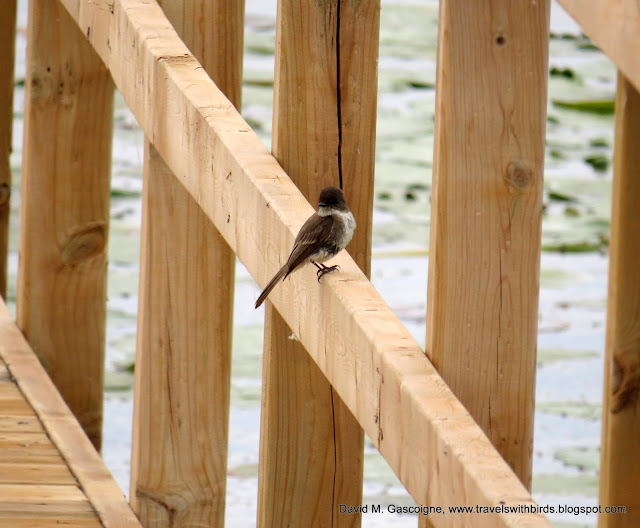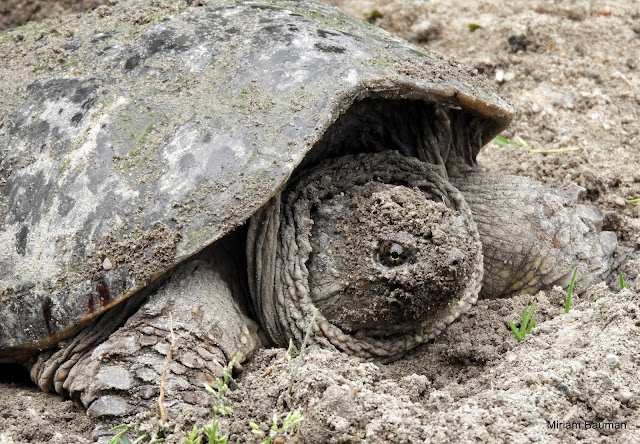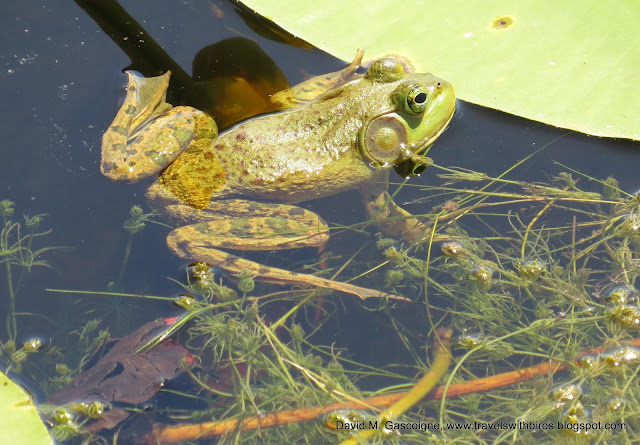13 June 2017
Carol and Judy could not join us for this outing but Franc, Jim, Francine, Mary, Miriam and I left home at 06:00 for the roughly two-and-a-half hour drive to Midland. This was a first visit to Wye Marsh for all of us and we were eagerly looking forward to it. The Trumpeter Swans Cygnus buccinator we love to visit at LaSalle Park and Marina in the winter have their principal breeding area at Wye Marsh and we were anxious to connect with them at this stage of their life cycle.
The marsh itself is a large area with many interesting trails to explore. Here are a few random shots of the areas that we traversed.
I had intended to inquire at the Visitor Centre whether the canoes could be rented, but I forgot to do so. I suspect they can be. We will check next time we visit and hire a couple for a few hours.
This would be an ideal way to glide through the channels to get to places that cannot be reached on foot.
It was not long before we spotted our first Trumpeter Swan, although as it turned out we did not see many. The birds are doubtless spread out over a wide area and probably have their nests in secluded areas. We are all wondering whether we will see J23 in Burlington this winter.
Some swans were spotted in flight and it is a rare treat to see them cruising over the marsh to splash down and disappear from view.
It was raining on and off for the early part of our visit, hence visibility was not great, and the light conditions for photographs less than desirable. A Belted Kingfisher Megaceryle alcyon teased us a little but finally perched for a picture.
A few Mallards Anas platyrynchos were hanging around with the lone Trumpeter Swan; all males. It is very likely that females are tending young but we never came across them.
The range of herpetofauna we encountered was pretty impressive, with American Bullfrogs Lithobates catesbeianus being especially common. Frequently we had several in view at a time and the mats of floating vegetation and the broad leaves of Yellow Pond Lilies Nuphar variegatum provided excellent resting places. This adult male shows the characteristic bright yellow throat.
It was great to see many groups of children on field trips and to observe their spontaneous enthusiasm as they dipped their nets into the water and retrieved treasures for all to study.
I am sure that they too were fascinated by the sound and sight of so many Bullfrogs.
I think it was Francine who first spotted a family group of Eastern Phoebe Sayornis phoebe and this youngster was learning to flycatch independently, although food delivered by a parent was eagerly accepted.
Franc wandered off by himself for a while, responding only to the dictates of his quest for birds, and was able to capture delightful images of a female Wood Duck Aix sponsa with a couple of ducklings.
Towards the end of the day we detoured by the area where he had seen them and everyone was able to get a good look.
We came across the shells of these Snapping Turtle Chelydra serpentina eggs and there was a discussion among us as to whether the eggs had hatched or whether a predator such as a Raccoon Procyon lotor had unearthed them and consumed the highly nutritious contents. Given the fact that eggs are laid May to July and hatching occurs fifty to one hundred days later, it seems very unlikely that this clutch could have been successful.
Snapping Turtles were frequently observed either seeking sites to lay their eggs or were in the process of so doing.
Miriam got down close to the ground and was able to get some interesting pictures.
We also discovered Midland Painted Turtles Chrysemys picta marginata but always in the water. None were encountered laying eggs.
Wherever we found turtles we found even more bullfrogs.
But who can resist a few more pictures? Not me...........
And obviously not Miriam.
This insect looks like it is placing itself in serious jeopardy.
We saw and heard numerous Common Yellowthroats Geothlypis trichas, a true denizen of the marshes.
Several Cedar Waxwings Bombycilla cedrorum kept us company. This is a species that never becomes ordinary - a truly beautiful creature.
As might be expected in a wetland with so many food resources Great Blue Herons Ardea herodias were anxious to exploit the bounty.
As we meandered along odenates were also observed including a Black Saddelbags Tramea lacerata......
........and Eastern Forktail Ischnura verticalis.
Several species of fern were to be seen, including dense stands of Ostrich Fern Matteuccia struthiopteris.
A Yellow-bellied Sapsucker Sphyrapicus varius was initially seen and then just as quickly disappeared. After a little searching, and a patient wait, it popped its head out of its nesting cavity in a tree.
Downy Woodpecker Picoides pubescens was quite common, including this female.
The habitat was nigh on perfect for Eastern Kingbird Tyrannus tyrannus, with abundant prey, and as might be expected they were observed throughout.
Several hirundines glided and swooped and we watched their incredible mastery of flight with a sense of awe. These birds are notoriously difficult to photograph as they are gone before the camera even has time to focus. Barn Swallow Hirundo rustica was the only species captured through the lens.
Song Sparrows Melospiza melodia were considerably easier.
We were quite delighted to discover a couple of Swamp Sparrows Melospiza georgiana, one quite open and Franc succeeded in getting this picture.
Miriam heard the distinctive song of Alder Flycatcher Empidonax alnorum and it too posed nicely.
By mid afternoon we decided to head for the exit and begin our journey home, wandering through very pleasant habitat.
It had been a great day with diversity enough to keep any naturalist happy. We know that we have barely scratched the surface of what Wye Marsh has to offer and we look forward to a return visit next year.
Some swans were spotted in flight and it is a rare treat to see them cruising over the marsh to splash down and disappear from view.
It was raining on and off for the early part of our visit, hence visibility was not great, and the light conditions for photographs less than desirable. A Belted Kingfisher Megaceryle alcyon teased us a little but finally perched for a picture.
A few Mallards Anas platyrynchos were hanging around with the lone Trumpeter Swan; all males. It is very likely that females are tending young but we never came across them.
The range of herpetofauna we encountered was pretty impressive, with American Bullfrogs Lithobates catesbeianus being especially common. Frequently we had several in view at a time and the mats of floating vegetation and the broad leaves of Yellow Pond Lilies Nuphar variegatum provided excellent resting places. This adult male shows the characteristic bright yellow throat.
It was great to see many groups of children on field trips and to observe their spontaneous enthusiasm as they dipped their nets into the water and retrieved treasures for all to study.
I am sure that they too were fascinated by the sound and sight of so many Bullfrogs.
I think it was Francine who first spotted a family group of Eastern Phoebe Sayornis phoebe and this youngster was learning to flycatch independently, although food delivered by a parent was eagerly accepted.
Franc wandered off by himself for a while, responding only to the dictates of his quest for birds, and was able to capture delightful images of a female Wood Duck Aix sponsa with a couple of ducklings.
Towards the end of the day we detoured by the area where he had seen them and everyone was able to get a good look.
We came across the shells of these Snapping Turtle Chelydra serpentina eggs and there was a discussion among us as to whether the eggs had hatched or whether a predator such as a Raccoon Procyon lotor had unearthed them and consumed the highly nutritious contents. Given the fact that eggs are laid May to July and hatching occurs fifty to one hundred days later, it seems very unlikely that this clutch could have been successful.
Snapping Turtles were frequently observed either seeking sites to lay their eggs or were in the process of so doing.
Miriam got down close to the ground and was able to get some interesting pictures.
We also discovered Midland Painted Turtles Chrysemys picta marginata but always in the water. None were encountered laying eggs.
Wherever we found turtles we found even more bullfrogs.
But who can resist a few more pictures? Not me...........
And obviously not Miriam.
This insect looks like it is placing itself in serious jeopardy.
We saw and heard numerous Common Yellowthroats Geothlypis trichas, a true denizen of the marshes.
Several Cedar Waxwings Bombycilla cedrorum kept us company. This is a species that never becomes ordinary - a truly beautiful creature.
As might be expected in a wetland with so many food resources Great Blue Herons Ardea herodias were anxious to exploit the bounty.
As we meandered along odenates were also observed including a Black Saddelbags Tramea lacerata......
........and Eastern Forktail Ischnura verticalis.
Several species of fern were to be seen, including dense stands of Ostrich Fern Matteuccia struthiopteris.
A Yellow-bellied Sapsucker Sphyrapicus varius was initially seen and then just as quickly disappeared. After a little searching, and a patient wait, it popped its head out of its nesting cavity in a tree.
Downy Woodpecker Picoides pubescens was quite common, including this female.
The habitat was nigh on perfect for Eastern Kingbird Tyrannus tyrannus, with abundant prey, and as might be expected they were observed throughout.
Several hirundines glided and swooped and we watched their incredible mastery of flight with a sense of awe. These birds are notoriously difficult to photograph as they are gone before the camera even has time to focus. Barn Swallow Hirundo rustica was the only species captured through the lens.
Song Sparrows Melospiza melodia were considerably easier.
We were quite delighted to discover a couple of Swamp Sparrows Melospiza georgiana, one quite open and Franc succeeded in getting this picture.
Miriam heard the distinctive song of Alder Flycatcher Empidonax alnorum and it too posed nicely.
By mid afternoon we decided to head for the exit and begin our journey home, wandering through very pleasant habitat.
It had been a great day with diversity enough to keep any naturalist happy. We know that we have barely scratched the surface of what Wye Marsh has to offer and we look forward to a return visit next year.


















































































What a amazing place! I love all your photos, with wonderful birds and other interesting animals. Great trip. Greetings!
ReplyDeleteHi David
ReplyDeleteBeautiful area.
Lots of beautiful animals to see.
Beautiful pictures
Groettie from Patricia.
Very interesting place. Love all the beautiful critters. Oh my! The bullfrogs are so big!
ReplyDeleteIt's spectacular to see all these species ! Biodiversity is fabulous.
ReplyDeleteFantástico y muy completo reportaje, me ha gustado mucho. Un lugar magnífico para disfrutar de la naturaleza en familia por lo que veo. Un fuerte abrazo desde España.
ReplyDeleteSome great pictures from that trip!
ReplyDeleteJust how amazing is nature.
ReplyDeleteLike the reflection on the water and the swan is beautiful. All photos infact.
Certainly worth the 2.5 hours drive to see this spot, it is beautiful. Love all the photos but especially of the bullfrogs, waxwing and woodpecker. Franc's bird shots are superb.
ReplyDeleteHope you have a good week Diane
Nice pictures everyone....I missed a good trip ;( Look forward to joining you next time. And seeing some of it by canoe is a great idea David.
ReplyDeleteWe missed you!
DeleteThe Frog are the brilliant, and various birds are excellent.
ReplyDeleteLooks like a fantastic place and not only for birds.........
ReplyDeleteWhat an amazing place for birding! Your photos of woodpeckers are great!
ReplyDeleteWonderful wetland, I can see that you have had a wonderful time with so many natural wonders, not only birds but turtles, frogs and a lush vegetation. I like the way the trails look
ReplyDeleteregards
What an amasing place to visit,and so well photographed and documented, very interesting.
ReplyDeleteAll the best, Gordon.
What a marvellous location, David! Your wonderful selection of photos bear witness to the richness of the area. Those canoes do appear to be an absolute must for your next visit - give a shout if you want a volunteer to paddle!
ReplyDeleteWith love to you both - - - Richard
David, I think this is one of your best ever posts ...
ReplyDeleteI so enjoyed all of the photographs, so much to see and what a terrific selection.
You had the most marvellous day and I am so pleased I was able to join in from my computer chair!
Thank you so much.
All the best Jan
What a trip. You really know your stuff! I live in a wetland and love it!
ReplyDeleteello David,
ReplyDeleteYou say you did not see many birds but nature is very beautiful. The still life of the water and the boats is really very beautiful. The trumpet swan has also been very successful. The kingfisher and the big frog are great to see. The yellow plump is also beautifully pictured.
I like the series of turtles and also the eggs very special to see. Great that we can enjoy this way in this way. Also many beautiful different birds with their beautiful colors :-) Dragonflies, woodpeckers and many birds. I really read this blog and watched it :-)
Best regards, Helma
Hallo David, this is again a great blog with some great pictures. On your question on my blog I wrothe an answer. No problems here I am in France.
ReplyDeleteWarm regards Roos
Beautifully varied blog David,
ReplyDeleteWhether the birds nature or the frogs are all beautifully photographed.
Greetings Tinie